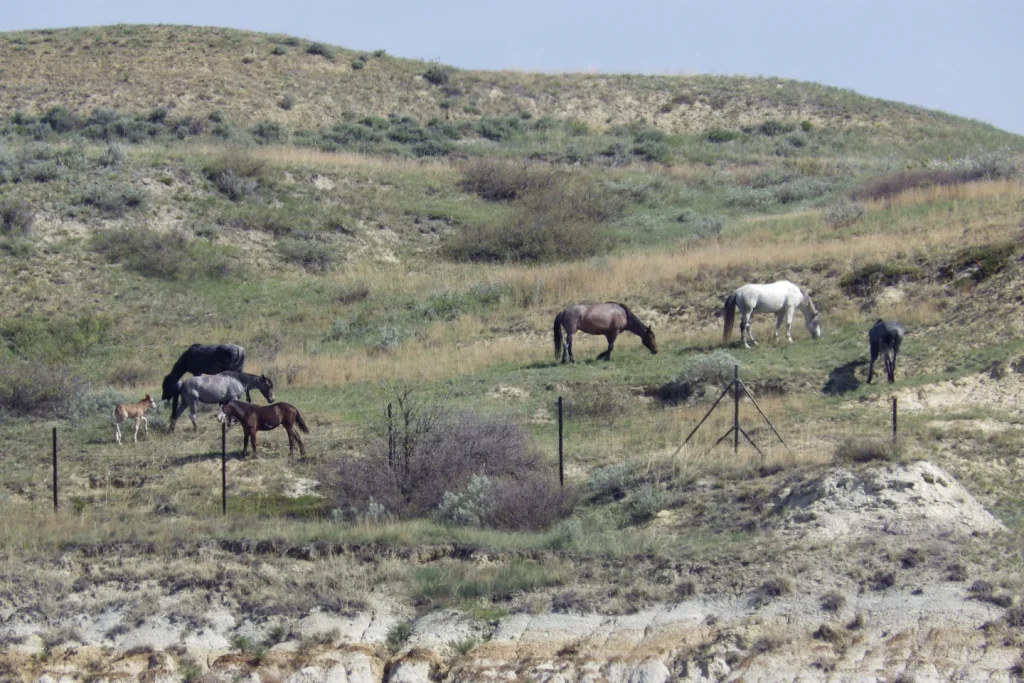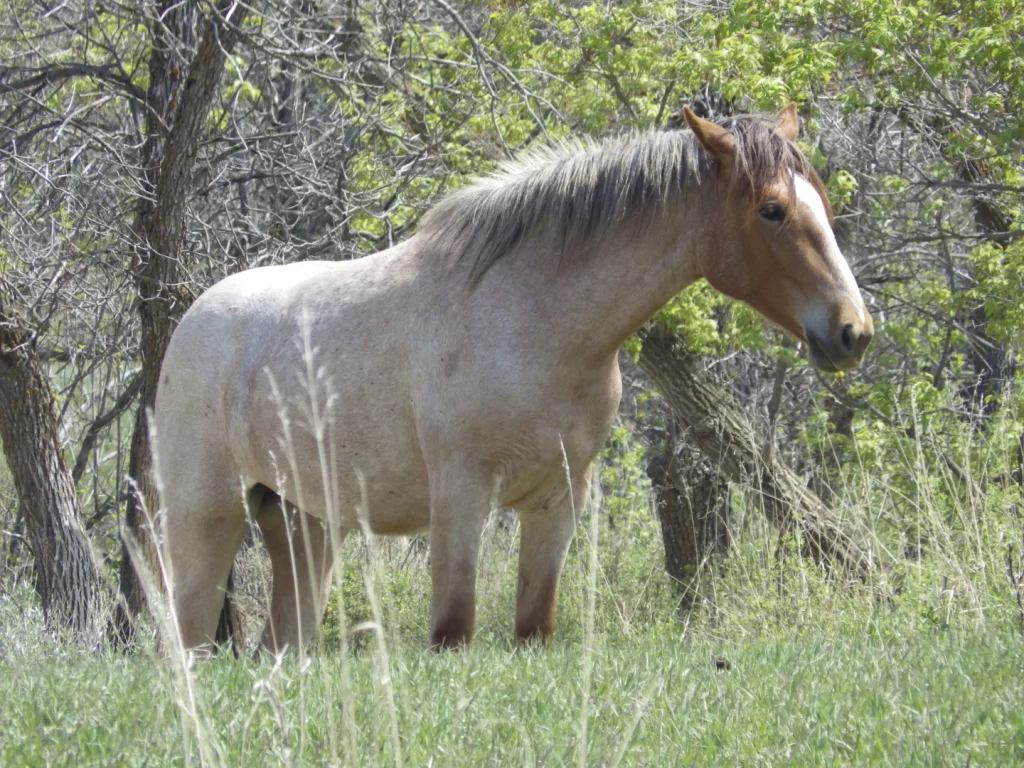The National Park Service, in its ongoing commitment to preserving the natural beauty and ecological balance of North Dakota’s Theodore Roosevelt National Park, has embarked on a collaborative effort with the public to determine the fate of the iconic wild horses that roam its vast expanse.
Commencing a 30-day public comment period on Monday, the federal agency aims to engage citizens and gather valuable insights regarding this crucial decision.
Concurrently, a draft environmental assessment of the wild horse herd has been made available, suggesting that the removal of these majestic creatures could potentially yield benefits for the native wildlife and vegetation within the park.
However, the report also acknowledges that such a course of action may inadvertently diminish the overall visitor experience, as many individuals specifically venture to the park to witness the awe-inspiring presence of the horses, as well as the cattle that share the landscape.
The Bismarck Tribune has dutifully reported on this development, highlighting the significance of striking a delicate balance between conservation efforts and the preservation of the park’s inherent allure.
In a formal statement released on Tuesday, North Dakota Republican Governor Doug Burgum expressed his unwavering commitment to advocating for the preservation of the wild horses within the park.
Governor Burgum emphasized the importance of maintaining the natural beauty and ecological balance of the park, recognizing the significant role that the wild horses play in this delicate ecosystem.
He highlighted the need for the National Park Service (NPS) to consider the long-term consequences of any decision regarding the wild horses, urging them to prioritize the preservation of these majestic creatures.
Governor Burgum’s stance on this matter reflects his deep understanding of the intricate relationship between wildlife and the environment, emphasizing the need for thoughtful and sustainable management strategies.
As a leader dedicated to preserving the natural heritage of North Dakota, Governor Burgum’s statement serves as a call to action, urging the NPS to carefully consider the implications of their decisions and work towards a solution that ensures the continued existence of the wild horses within the park.
The statement made by Burgum regarding the horses as a popular tourist attraction is a testament to the significance of these majestic creatures in the region.
These horses serve as a symbol of the untamed spirit of the Badlands, which is a stark contrast to the modern world we live in today.
Moreover, these horses also remind us of the deep ties to Roosevelt’s ranching and conservation legacy, which is an essential part of the region’s history.
The conservation efforts of Roosevelt have been instrumental in preserving the natural beauty of the Badlands, and the horses are a living reminder of his legacy.
The fact that these horses have managed to survive and thrive in the region despite the harsh conditions is a testament to their resilience and adaptability.
Therefore, it is no surprise that these horses have become a popular tourist attraction, drawing visitors from all over the world who want to experience the untamed spirit of the Badlands and pay homage to Roosevelt’s conservation legacy.
In regards to the topic at hand, it is worth noting that during Roosevelt’s transformative years in the Badlands, the presence of wild horses was a notable aspect of the landscape.
This period coincided with significant milestones in the establishment of the park, such as President Truman signing the bill that created it in 1947, and its subsequent recognition as an official national park in 1978.
The inclusion of wild horses in this narrative serves as a testament to the rich history and natural beauty of the area, highlighting the importance of preserving and appreciating such unique wildlife.
The proposal put forth by the federal agency has caused concern among advocates who strongly believe that the horses are an integral part of the cultural heritage of the region.
These advocates are deeply opposed to the park officials’ characterization of the horses as mere “livestock”. They argue that the horses are much more than that, and are in fact a living embodiment of the history and traditions of the area.
To them, the horses represent a link to a bygone era, and their presence serves as a reminder of the rich cultural legacy that has been passed down through the generations.
The advocates fear that if the proposal is implemented, it could lead to the gradual disappearance of the horses, and with it, a significant part of the region’s cultural heritage.
They believe that the horses must be protected and preserved, and that their importance as a cultural symbol cannot be underestimated.
Visitors who embark on a scenic drive along the park road are frequently greeted with the awe-inspiring sight of bands of horses.
This is a symbol of the West that has captivated the hearts of tourists for generations. The sight of these majestic creatures roaming free amidst the natural beauty of the park is a truly breathtaking experience. The horses’ grace and power are a testament to the enduring spirit of the American West, and their presence serves as a reminder of the region’s rich cultural heritage.
Indeed, the sight of these bands of horses is one of the highlights of any visit to the park, and it is no wonder that it continues to captivate and delight visitors from all over the world.
The topic at hand revolves around the potential removal of horses from a certain location. The proposed course of action would involve the capture of these horses, followed by the distribution of some of them to tribes.
Subsequently, the remaining horses would be either auctioned off or given to other entities. Alternatively, another approach could be implemented, which would focus on preventing future reproduction of the horses while allowing them to continue residing in the park for the remainder of their lives.
Both of these strategies present potential solutions to the issue at hand, aiming to address the concerns surrounding the horse population in a thoughtful and efficient manner.
In the annals of the park’s rich history, a peculiar incident stands out, one that has captivated the minds of researchers and enthusiasts alike.
It was in the year 1947, when the foundations of the park were laid, that a fortuitous turn of events led to the inadvertent enclosure of a couple bands of wild horses within its boundaries.
This serendipitous occurrence, as recounted by the esteemed Castle McLaughlin, a graduate student at the time, would later become a focal point of her research while working for the Park Service in the picturesque landscapes of North Dakota during the 1980s.
With a meticulous dedication to unraveling the enigmatic origins and compelling history of these equine inhabitants, McLaughlin embarked on a journey that would unveil a trove of knowledge and shed light on the captivating tale of the wild horses that found themselves unwittingly fenced into the very fabric of the park’s existence.
I would like to express my thoughts and opinions regarding the recent discussion on whether the wild horses that roam Theodore Roosevelt National Park should be allowed to stay.
It is indeed fascinating to learn about the historical background of these horses and the efforts made by park officials to preserve them as a historic demonstration herd.
The revelation that park officials in the early years sought to eradicate the horses is quite shocking. The fact that they were shot on sight and local cowboys were hired to round them up and remove them highlights a rather brutal approach. Additionally, the sale of horses to a local zoo as food for large cats is disheartening to hear.
However, the turning point came around 1970 when a park superintendent discovered that Theodore Roosevelt himself had written about the presence of wild horses in the Badlands during his time there.
This discovery must have been a significant moment for the park officials, as it provided a historical context and a deeper understanding of the importance of these horses.
The decision to retain the horses as a historic demonstration herd to interpret the open-range ranching era is commendable.
By allowing the horses to stay, the park not only preserves a piece of history but also provides visitors with an opportunity to witness and appreciate the living legacy of Theodore Roosevelt’s time in the Badlands.

I believe that the presence of wild horses in Theodore Roosevelt National Park adds to its uniqueness and charm. These majestic creatures are not only a part of the park’s history but also contribute to its ecological balance.
They play a vital role in maintaining the natural vegetation and biodiversity of the area, and their presence enhances the overall visitor experience.
Furthermore, the wild horses have become an iconic symbol of the park, attracting tourists from all over the world.
People are captivated by their beauty and grace, and the opportunity to observe them in their natural habitat is a rare and awe-inspiring experience.
Their presence adds to the allure of the park and contributes to its reputation as a must-visit destination.
In conclusion, I strongly believe that the wild horses should be allowed to stay in Theodore Roosevelt National Park.
Their historical significance, ecological importance, and contribution to the overall visitor experience make them an essential part of the park’s identity.
I urge park officials to consider the long-term benefits of preserving these horses and to continue their efforts to protect and sustain their population.
